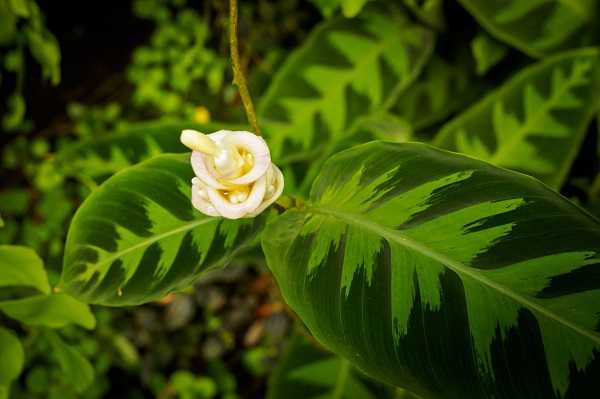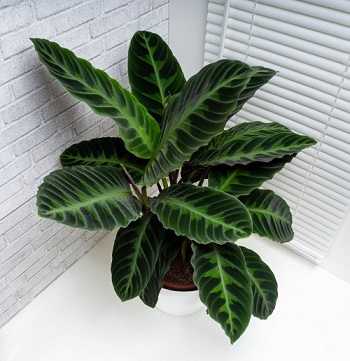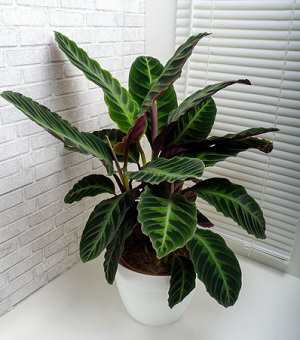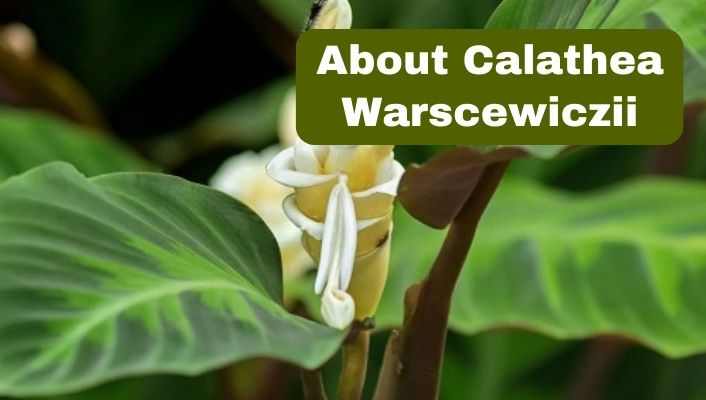We know that tropical calathea plants are known for their stunningly beautiful patterned leaves. In this article, we’ll learn about the Calathea warscewiczii care, one of the most remarkable varieties of Calathea plants.
The best feature of this plant is that it has remarkable velvety foliage with tops colored in two shades of green and beautiful burgundy undersides. Read on to learn more about it!
Post Contents
- Calathea Warscewiczii Basic Info:
- Calathea Warscewiczii Characteristics:
- Size and Growth
- Calathea Warscewiczii Care and Maintenance
- Light Requirements
- Watering the Calathea Jungle Velvet
- Temperature Boundaries
- Humidity Requirements of the Plant
- Best Kind of Soil
- Fertilizing
- Pruning
- Repotting and Propagation
- Frequently Asked Questions:
- Conclusion
- Author
Calathea Warscewiczii Basic Info:
| Attribute | Description |
|---|---|
| Scientific Name | Calathea warscewiczii |
| Common Name | Warscewicz’s Calathea |
| Family | Marantaceae |
| Origin | Costa Rica and Nicaragua |
| Plant Type | Perennial |
| Height | Up to 2 feet (60 centimeters) |
| Leaf Color | Dark green with silver patterns |
| Leaf Shape | Oval to elliptical |
| Pet-Friendly | Non-toxic to cats and dogs |
| Air Purifying | Yes |
| Humidity Needs | High |
| Temperature Range | 65°F to 80°F (18°C to 27°C) |
Calathea Warscewiczii Characteristics:
Calathea Warscewiczii is also known as the Calathea Jungle Velvet. It is native to the tropical rainforests of Central and South America. It is a really beautiful and exotic plant.
Moreover, the color combination of two greens and burgundy gives it an extra look boost. The leaves of Jungle Velvet are very soft and give a velvety feeling.
They have a light and dark greenish pattern similar to a fishtail. Besides all this, the burgundy mixed purple colored undersides take the beauty level to a whole next level.
That’s not all; if this plant is cared for well, it can have small flowers in the growing season. The typical color of Calathea Warscewiczii flowers is cream-like.

Size and Growth
Generally, the size of the Calathea Jungle Velvet grows up to 3 to 4 feet high. These houseplants need some optimal conditions in which they grow perfectly and fast.
In the following article, you’ll find everything you need to know about caring for and maintaining this specific plant. We have tried to cover every aspect related to it.
Also Read: Calathea Crocata Care & Growing (Eternal Flame Plant)
Calathea Warscewiczii Care and Maintenance
Let’s get into the guide specifically designed for the care and maintenance of Calathea Warscewiczii. We have covered all the points to help you keep the plant healthy and happy.
Light Requirements
Calathea warscewiczii requires bright but indirect light as it is a native of rainforests, where it interacts with shady environments. The direct and high rates of sunlight can eventually burn out its leaves.
Always go for a north-facing window that receives adequate light, but ensure that the plant is in the shade. You can take your plant outside in the morning and evening, but be careful because the hot afternoon rays can be dangerous.

A quick test for adequate light is that if you can read easily in the light the plant is placed in, it is sufficient. Remember that light also has a connection with correct levels of humidity. So keep both things in check.
Watering the Calathea Jungle Velvet
As we know that all Calathea varieties require high maintenance. So is the case that Warscewiczii needs this too. Watering is one of the most important part of Calathea warscewiczii care.
Never let the soil become too dry or never too soggy and watery. You have to keep a check on your plant’s watering needs because they have to adjust a lot in house environments.
You can use a moisture meter, but if you haven’t got your hands on one, you can always check using your finger. Lightly press on the topsoil; if it’s hard and dry, it’s time to water the plant.
When the Warscewiczii is in its growth period, especially during the warm summer months, the watering routine should be like when the top 1 or 2 inches of the soil dry, and you should water it. If you are watering thoroughly, ensure that the pot has good drainage holes.
Talking about winter and cold seasons, you do not have to water the plant much. Just water it once every 3 to 4 weeks. Or water it when you notice that the soil is becoming too dry. Too much watering in winter can lead to root rot.
Always opt for warm room temperature water and use distilled or purified water. Because tap water contains many minerals and salts, Calathea Warscewiczii is sensitive.
Temperature Boundaries
Tropical houseplants always prefer normal room temperature, just like humans do. So the Calathea warscewiczii grows well if your house has a constant warm temperature. They require warmth during their growing periods. The ideal temperatures range from 65-85ºF (18-29ºC). But they can take up to 90ºF (32ºC) or above only if there is sufficient humidity.
The plant growth slows down a lot in cold weather. If the temperature goes below 60ºF, it will not thrive, and the leaves will start to get damaged. Plus, it would help if you always avoid sudden temperature changes.
Remember to keep your plant in a spot that is away from any winds coming from leaky windows, opening/closing doors, or vents blowing heat in the winter and cool air in the summertime. These plants can get damaged even from a brief chill.
Related Post: Calathea Rufibarba Care (Propagation & Growing Tips)
Humidity Requirements of the Plant
The main reason that some collectors call the Jungle Velvet a fussy plant is that it needs higher humidity than a normal home has. They start to get limp and dry when the moistness in the air is low.

The ideal humidity for Calathea Warscewiczii is above 50%. You can take help from a low-cost hygrometer to maintain the right level.
We have made up several points through which you can increase the humidity of your plant:
- Because of the steamy showers, you can keep your plant in a bathroom that can stay moist.
- Keeping your Jungle Velvet with other plants will help it stay humid through transpiration.
- An easy way is to use a tray filled with water and pebbles. Place the plant pot over it. The phenomenon of evaporation can do wonders.
- Invest in a good room humidifier.
- Mistake your plant using distilled water, but don’t overdo it because it will lead to leaf diseases.
Best Kind of Soil
The soil mix should be good because it’s critical for perfect Calathea warscewiczii care. The soil medium should have the capacity to hold enough water for the roots to stay moist. Along with this, the soil must be airy and shouldn’t get soggy.
Many people recommend using perlite, pumice, and coarse sand because they keep the soil airy, but they don’t keep the soil moist. We recommend mixing one part of perlite with two parts of peat or coir in good potting soil. This will give you a great soil recipe for your Warscewiczii.
You can use compost or peat for some organic fertility boost, but this has some side effects. These materials decompose over time and will make a blockage in the aeration of the soil. If you do this, remember to replenish the medium after a few seasons.
Fertilizing
These plants do not require heavy fertilizing, and you have to add a little fertilizer during the warm growing months of the plant.
Opt for a balanced fertilizer, or you can go for nitrogen and phosphorus-rich fertilizer. Buy a liquid-based one, or you can dilute it before adding it to your plant.
It’s better to give it a little fertilizer because an overdose can damage the roots and even burn the plant.
Pruning
It doesn’t need a lot of pruning. But you can give your plant a shrub-like look by removing old or damaged leaves. A benefit of pruning is that it can stimulate new foliage.
Always use sharp, sterilized tools and cut the base of the leaf where it meets the stalk.
Related Article: Calathea Makoyana – Peacock Plant (Care & Growth Guide)
Repotting and Propagation
Repot your plant only if you notice slow growth and rootbound. Choose a slightly larger container than the present one. We recommend doing this every 1-2 years, but it varies on the conditions the plant is being provided with.
Furthermore, the best time for repotting is springtime or early summer. Because during springtime, the plants begin actively growing after the cooler winter months.
Always add new potting soil by mixing the one mentioned above in the soil section. You can add compost to the mix for a nutrient refresh. Make sure to loosen up the roots if they are root bound.
The most common and easy way to propagate Calathea Warscewiczii is by dividing their rhizome. Be as gentle as possible because this plant doesn’t like its roots disturbed.
Frequently Asked Questions:
Is Calathea Warscewiczii hard to care for?
The Calathea Warscewiczii needs some optimal conditions to grow well. If you keep a check on the proper conditions, then the caring level is quite moderate.
Why does Calathea Warscewiczii have brown leaf tips?
If this is happening, it may be too dry for this tropical plant to grow, or maybe the reason can be tap water. If you want to eliminate this, follow the tips explained above.
Can Calathea Warscewiczii Flower?
Yes, they can flower, but it is not frequent. Tiny cream-colored flowers may sometimes be seen on mature plants throughout the year. But this is not usual and can only be seen if the plant is cared for well.
Is Calathea Warscewiczii toxic?
No! Like many other Calathea species, Calathea Warscewiczii is not toxic to humans and household pets.
Can I spray mist my Calathea Warscewiczii?
Yes! You can mist your Calathea regularly (once a week is ideal) to ensure it receives the moisture it craves.
Conclusion
Winding up the article about this beautiful plant, we have to say that this is an ideal choice as a houseplant. Though it is a bit fussy to care for this plant, once you stick to these points we discussed, it can be a piece of cake for you.
We hope that you have understood all the essentials for Calathea warscewiczii care. Now be sure to get a Calathea Warscewiczii as you are prepared to care for it.
Few Related Articles:

